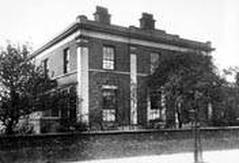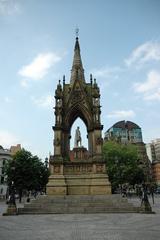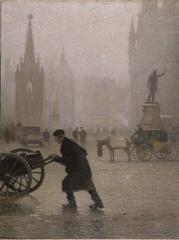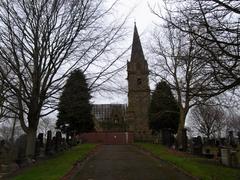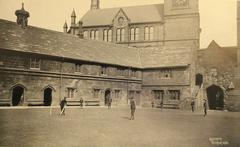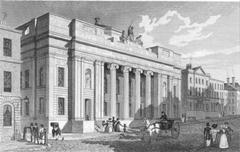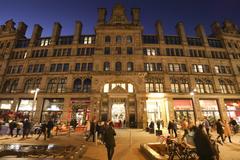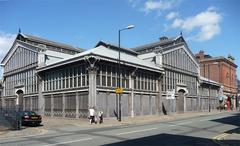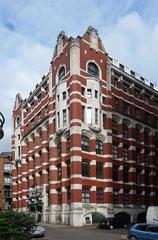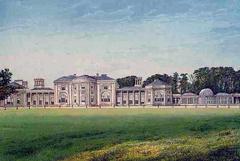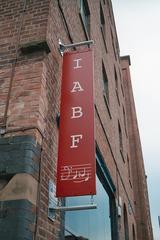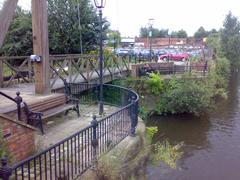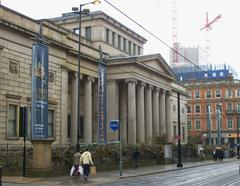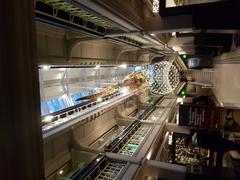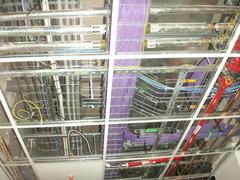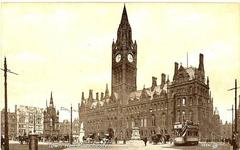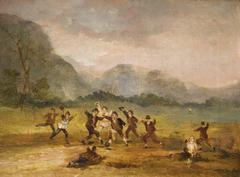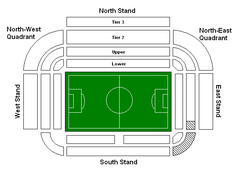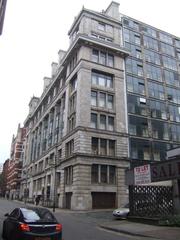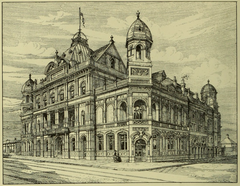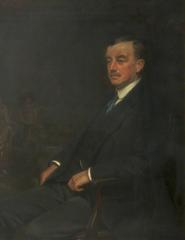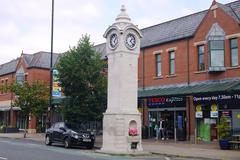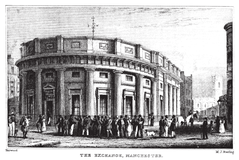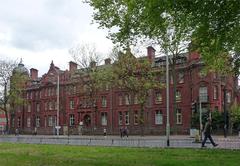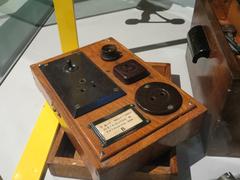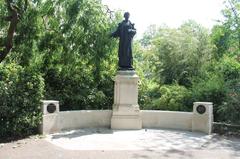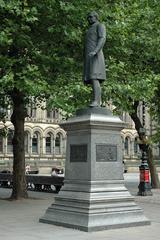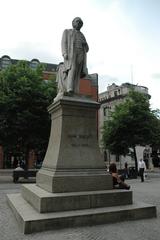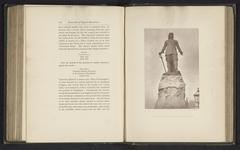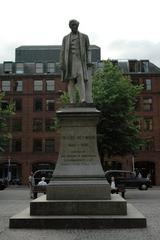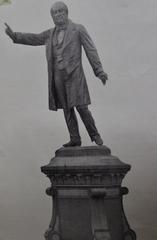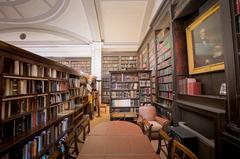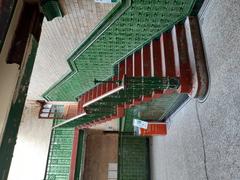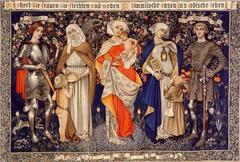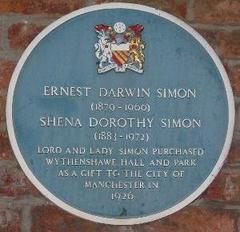Manchester Cenotaph Visiting Hours, Tickets, and Historical Sites Guide
Date: 15/06/2025
Introduction: The Manchester Cenotaph’s History and Cultural Significance
The Manchester Cenotaph is a deeply significant war memorial, located at the heart of St Peter’s Square in Manchester. Designed by the renowned British architect Sir Edwin Lutyens and unveiled in 1924, the monument stands as a solemn tribute to the men and women who sacrificed their lives during the First World War and subsequent conflicts. Lutyens’ design, which avoids overt religious symbols and individual names, emphasizes collective memory and universal sacrifice. Crafted from Portland stone, the Cenotaph features a central pylon, flanking obelisks, and a Stone of Remembrance, and is harmoniously integrated into Manchester’s urban landscape, flanked by the historic Town Hall and Central Library.
The site is freely accessible at all times, with no admission fee or ticket requirement. Its central location is well-served by public transport, including the Metrolink tram network and multiple bus routes, and is fully wheelchair accessible. The Cenotaph is also the focal point for major annual commemorative events such as Remembrance Sunday and Armistice Day, attracting thousands who gather to honor the fallen. For more on visiting hours, accessibility, and nearby attractions, see Lutyens Trust, Visit Manchester, and Evendo.
Table of Contents
- Introduction
- History of the Manchester Cenotaph
- Visiting Information
- Social and Community Role
- Practical Visitor Tips
- Frequently Asked Questions
- Conclusion
- References
History of the Manchester Cenotaph
Early Commemoration Efforts
Manchester was slower than many British cities to establish a First World War memorial, only forming its memorial committee in 1922, years after the war’s end (Wikipedia; Everything Explained Today). The delay stemmed from civic debates and the challenge of uniting various stakeholders. Despite the late start, local fundraising quickly met its £10,000 goal, with the public motivated by both civic pride and the promise of local job creation (NMBS2001).
Site Selection and Design
Selecting a site involved considerable debate. Options included Albert Square and Piccadilly Gardens, but St Peter’s Square was eventually chosen—on the site of the former St Peter’s Church, whose crypts remain beneath the square (Everything Explained Today). The design commission went directly to Sir Edwin Lutyens, already famous for his London Cenotaph. Lutyens’ approach was characterized by classical restraint and abstract symbolism, creating a memorial that transcended religious and political boundaries (Lutyens Trust).
Architectural Features and Symbolism
The Manchester Cenotaph comprises a central pylon, two flanking obelisks, and a Stone of Remembrance, all in Portland stone (Vetter UK). The cenotaph rises to around 10 meters, crowned by a stone wreath. The flanking obelisks echo ancient Egyptian forms, signifying endurance and eternity. The altar-like War Stone, inscribed “Their Name Liveth For Evermore,” is a hallmark of Lutyens’ memorials, emphasizing the continuity of remembrance. Notably, the memorial contains no names—an intentional abstraction, allowing the monument to represent all who served (Lutyens Trust).
Construction, Unveiling, and Legacy
Completed in summer 1924 at a cost of £6,940, the Cenotaph was unveiled on 12 July 1924 by the Earl of Derby, joined by Mrs. Bingle, a local mother who lost three sons in the war (Geo.io). The event was marked by solemn ceremony and public tribute. The Cenotaph quickly became Manchester’s principal site for annual commemorations, including Remembrance Sunday and Armistice Day (Explorial).
Relocation and Conservation
Urban redevelopment and tram expansion led to the Cenotaph’s careful relocation in 2014, moving it approximately 100 meters within St Peter’s Square (Vetter UK; Everything Explained Today). The process involved meticulous dismantling, conservation, and reassembly, ensuring the protection of both the memorial and the underlying church crypts. The Cenotaph is now Grade II* listed, recognizing its exceptional architectural and historical significance.
Visiting Information
Hours and Tickets
- Open 24 hours a day, 7 days a week
- Free entry; no tickets required
(Evendo)
Accessibility
- Wheelchair accessible: Level, paved paths and ramps throughout
- Public transport: St Peter’s Square Metrolink stop is adjacent; major bus routes nearby
- Car parking: Several city centre car parks; walking and tram access recommended
(Visit Manchester)
Getting There
- By train: Manchester Piccadilly Station (15–20 minutes’ walk or direct tram)
- By tram: St Peter’s Square stop, served by all major lines
- By bus: Central bus station is a short walk away
(Evendo; Manchester Victorian Architects)
Guided Tours and Visitor Tips
While there is no official guided tour devoted solely to the Cenotaph, it features in many city walking tours and heritage trails. For a deeper understanding, join a local tour or use a mobile audio guide. During Remembrance events, arrive early due to crowds, and dress warmly in November (Guide.in.ua).
Nearby Attractions
- Manchester Town Hall: Victorian Gothic masterpiece
- Central Library: Iconic domed structure and research hub
- Manchester Art Gallery: Extensive art collections
- John Rylands Library: Neo-Gothic architectural gem
- The Royal Exchange Theatre: Historic performance venue
St Peter’s Square is also near shops, cafés, and public facilities, making it an ideal starting point for further exploration (Visit Manchester).
Ceremonies and Commemorative Events
The Cenotaph is the focal point for Manchester’s Remembrance Sunday and Armistice Day ceremonies, featuring wreath-laying, a two-minute silence at 11 am, and the Last Post. These events gather veterans, civic leaders, and the public in acts of solemn remembrance (The Independent). Outside formal events, visitors often leave poppies and floral tributes throughout the year.
Best Photographic Spots
- Front façade: Captures the recumbent warrior effigy
- Obelisks: Symmetrical framing of the central pylon
- Gardens: Seasonal plantings add color and serenity
- Early morning/late afternoon: Optimal natural light for photography
Social and Community Role
The Manchester Cenotaph remains central to the city’s collective memory. Its inclusive design and public ceremonies foster a sense of shared identity, welcoming people of all backgrounds. Community groups and schools regularly visit for educational and commemorative purposes, and the site hosts multicultural and interfaith events (Manchester’s Finest).
Practical Visitor Tips
- Best time to visit: Early morning or late afternoon for tranquility and best lighting
- Weather: Pack layers and waterproofs; November ceremonies can be cold and shaded (Clothes Forecast)
- Etiquette: Maintain a respectful demeanor; photography allowed, but be discreet during ceremonies
- Facilities: Public toilets, shops, and cafés nearby
- Visitor Information: City visitor centres offer maps, advice, and luggage storage (Visit Manchester)
Frequently Asked Questions
Q: What are the Manchester Cenotaph’s visiting hours?
A: The Cenotaph is open 24/7 and free to visit.
Q: Is the Cenotaph wheelchair accessible?
A: Yes, with level paths and ramps throughout.
Q: Are guided tours available?
A: Not exclusively, but many city tours include the Cenotaph.
Q: How do I get there by public transport?
A: Metrolink trams (St Peter’s Square stop), buses, and nearby rail stations.
Q: Can I take photos?
A: Yes, but please be respectful, especially during ceremonies.
Q: What events are held at the Cenotaph?
A: Remembrance Sunday and Armistice Day are the main annual ceremonies.
Conclusion
The Manchester Cenotaph stands as a profound symbol of remembrance in Manchester, uniting architectural excellence with deep civic meaning. Open at all hours with no entry fee, it welcomes everyone for reflection or participation in city traditions. Its accessible location, thoughtful design, and connection to Manchester’s history make it a must-visit for both locals and visitors. Enhance your experience by exploring nearby landmarks and utilizing official resources such as city visitor centres and the Audiala app for up-to-date tips and tours.
Plan your visit to the Manchester Cenotaph and discover one of the city’s most significant historical and cultural sites.
